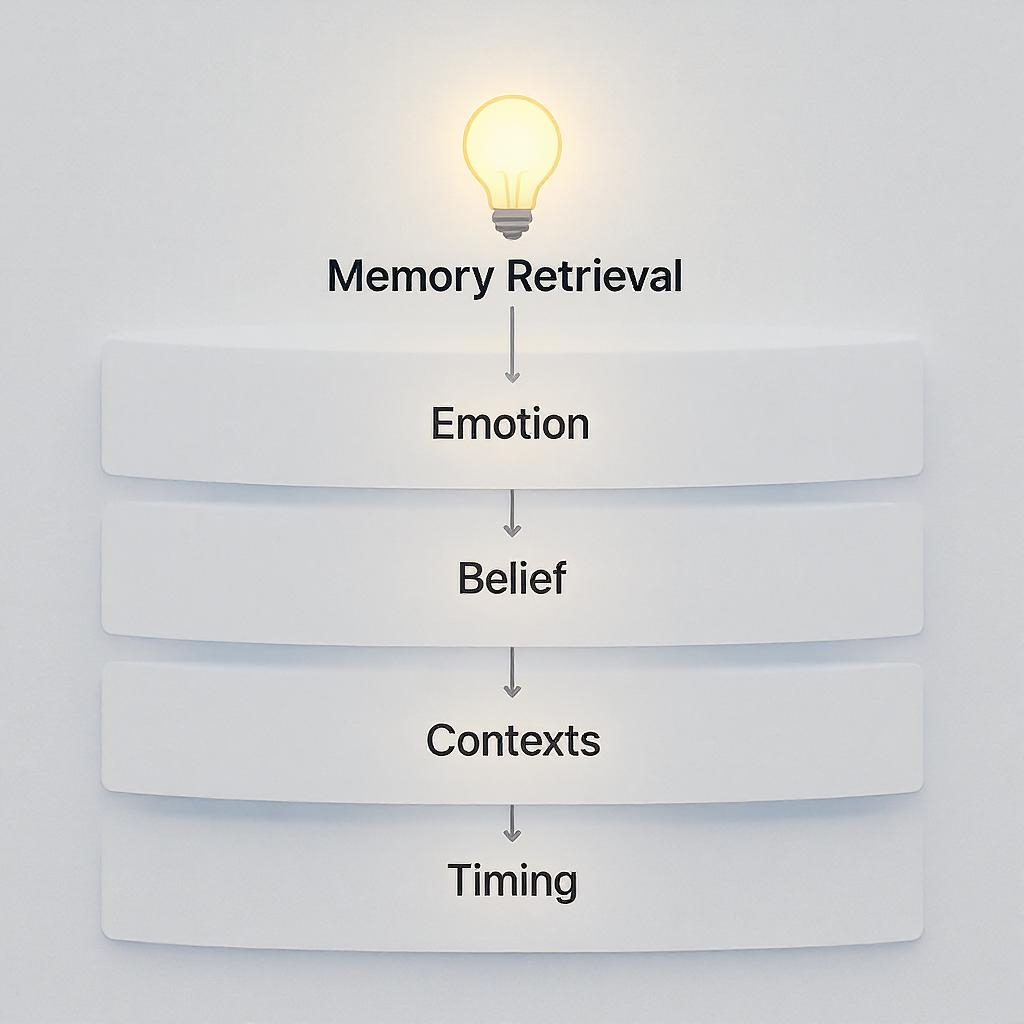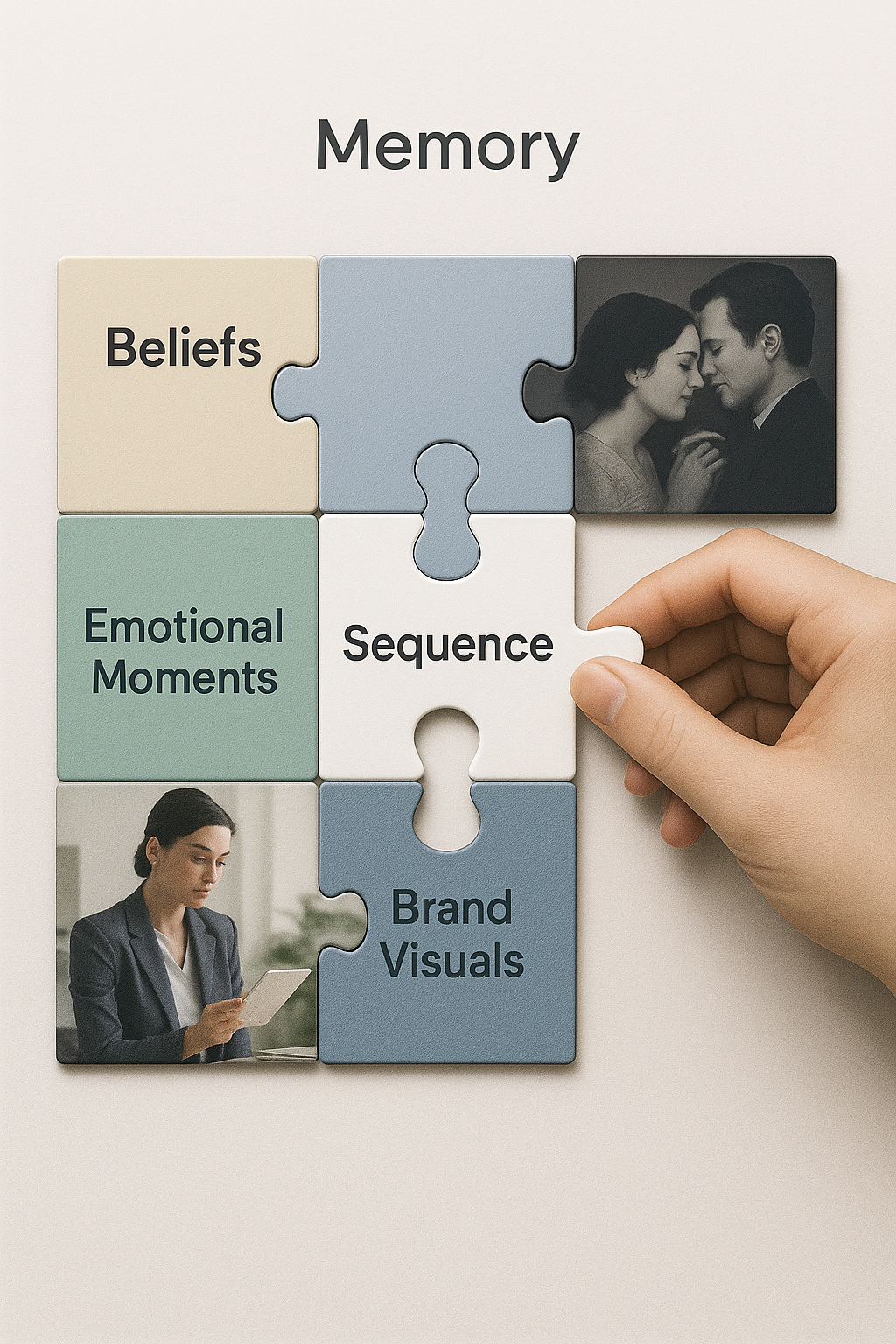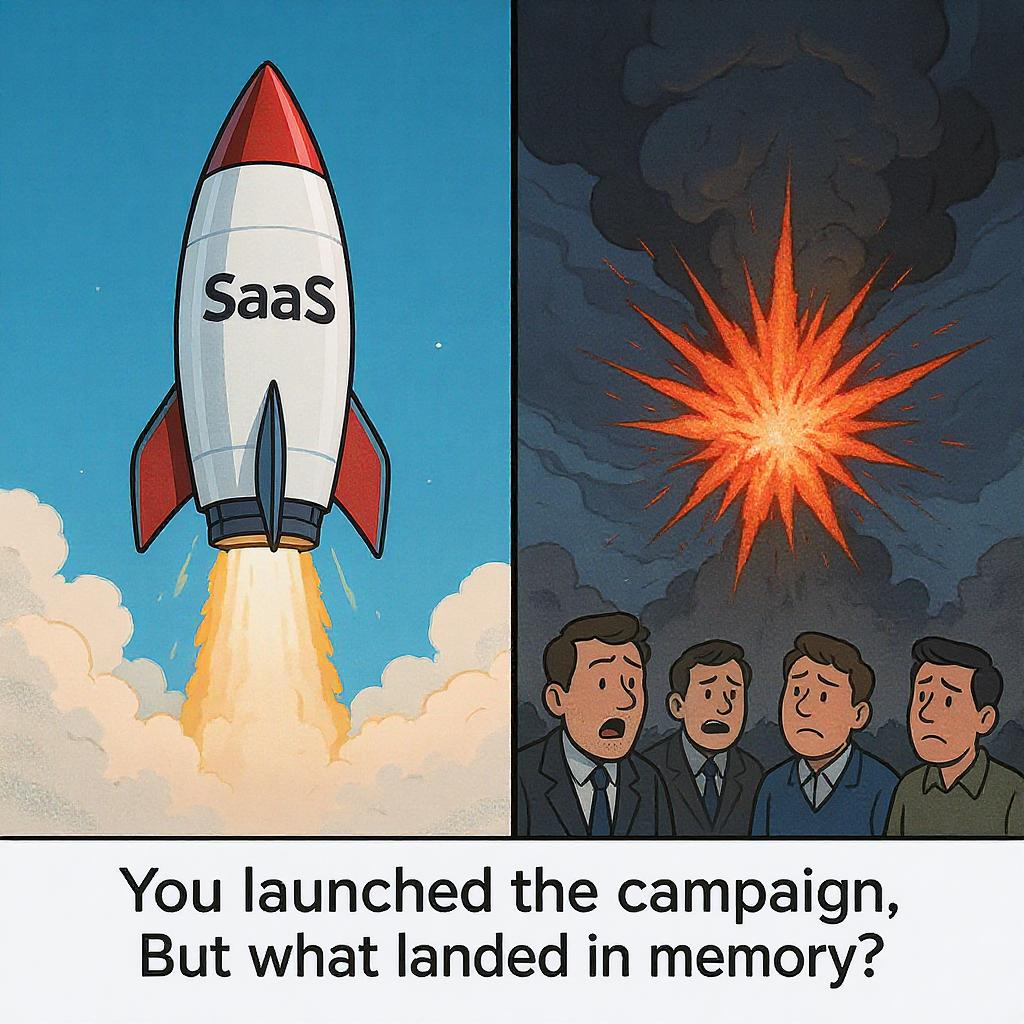![image of a busy downtown area for a mobility and transportation business [background image]](https://cdn.prod.website-files.com/683cad1a6d119a92710e1883/686c6e605e2ee4b46b459027_openart-image_H9Qk0uZ5_1751936524218_raw.jpg)
If you ask what brand awareness means, you’ll probably hear answers like:
"Being top-of-mind"
"Being remembered at buying moments"
"Being known within a category"
"Getting our name out there"
"Making people recognize the logo"
That sounds right, but it’s surface-level.
It reduces brand building to visibility and repetition. It assumes the game is only about being seen and remembered.
That’s a problem.
Because what if you're being remembered for the wrong things?
We used to Think we are Building Awareness
In reality, brands were boosting impressions. Chasing vanity metrics. Optimizing headlines for clicks, not memory.
They’re pouring money into reach, while ignoring what actually gets stored and recalled when it matters.
Marketing became obsessed with numbers and chasing attention. But attention is scarce, and it doesn’t necessarily lead to growth, especially when it’s fueled by hype with no connection to the actual problem you solve.
But brand awareness isn’t a CPM. It’s not a traffic spike. It’s not last week’s brand recall survey.
Real brand awareness is built across time, across touchpoints, and through emotionally resonant moments that stick and resurface when a buyer is making a decision.
.jpg)
Current growth strategies and GTM are too focused on visibility and not focused enough on memorability.
And even when brands are being remembered, it’s often for the wrong reasons:
Why? Because they’re still focused on the wrong things.
Chasing attention. Speaking to everyone the same. Hype Campaigns and spamming lead magnets.
But not journey-mapping. Not belief-building. And for sure not building brand awareness with the right memory association that help buyers see the value of your brand and offering.
So we get brands people see everywhere and remember nowhere.
Traditional brand awareness theory (Keller, Rossiter, Percy) defines it as:
“The ability of the buyer to recognize or recall the brand when given a product category or need.”
It was a starting point, but with dangerous limitations:
So the focus centered around optimizing for being remembered no matter the context.
They proposed an updated definition:
“Brand awareness is the likelihood that a person retrieves a brand identifier and a category need from memory across brand-relevant situations.”
This shifted the focus to:
It acknowledged people remember fragments. A symbol, a sentence, a sound that bring a brand into focus. An ad that resonates or sticks for the wrong reason.
But even this missed something critical!

Most theories talk about "recall" and "recognition." But those are outcomes. They don’t explain how to build brand awareness, especially in today’s digital, fragmented world.
Here’s the more complete process — the Sequence Theory view:
Every time someone sees a LinkedIn post, hears a founder speak, uses the product, or hears about the brand from a peer — that’s a memory trace. Not all traces are equal — meaningful, emotional, or problem-relevant ones stick deeper.
Logos, colors, sounds, slogans — these brand identifiers act as shortcuts in memory. But awareness also comes from ideas and beliefs. People might forget the name but remember what the brand stands for.
Awareness is useless if it’s not linked to a problem or need. You want your brand to come to mind when someone says:
That means awareness needs to be situational and problem-aligned.
Brand awareness is performance memory. The goal isn’t to be remembered randomly — it’s to be remembered when it matters. That could be:
This is why belief-led content and educational moments matter so much. They create episodic memories that stick.
Brand awareness is the result of being remembered. But it shouldn’t be limited to recall at the moment of purchase. It should bring the right belief and benefit associations to mind, so you're remembered for what matters in every brand-relevant situation.
Our refined definition:
Brand awareness is the likelihood that brand identifiers, beliefs, and emotional impressions are retrieved from memory across all relevant contexts. This includes, but is not limited to, purchase moments. It also applies to conversations, content, evaluation, and discovery.
This reframes the entire model:
- From “Who are you?” to “What do I believe about you?”
- From name recall to meaning retrieval
- From visibility to memorability
- From Stickiness to relevance
Bergkvist & Taylor (2022) advanced the theory:
“Brand awareness is the likelihood that a person retrieves a brand identifier and a product category or need from memory across brand-relevant situations.”
Great progress—but it didn’t explain how to build that awareness.
We asked:
What creates memory traces strong enough to drive brand retrieval at the right time?
The answer wasn’t:
More impressions
Better recall scores
Bigger reach
It was belief-led sequencing.
Ask most people what comes to mind with HubSpot:
“Inbound marketing”
“Content and lead gen machine”
“CRM for small businesses”
“Friendly, helpful, orange”
But people don’t recall HubSpot for features.
They remember the belief:
“Don’t interrupt. Attract.”
Why did that stick?
A clear belief system: “Traditional marketing is broken. Inbound is the future.”
A consistent content engine: Templates, blogs, webinars—built to teach, not just convert
Strong visual identity: Orange everywhere, human tone
Category framing: They didn’t just sell software. They framed a philosophy.
Stored memory traces:
A color (orange)
A category (inbound)
A feeling (helpful, modern)
A belief (“Give value. Don’t spam.”)
A utility (free CRM)
People forget the landing page builder. But they remember what HubSpot stands for.
We don’t view brand awareness as a media metric.
We view it as a system of stored memory.
4 Blind Spots in Classical Theory:
- Repetition is overvalued
- Emotion and relevance create memory, not just frequency.
- Emotion is missing
We store what we feel—tension, surprise, inspiration.
Touchpoints are isolated, but memories are built across sequences.
Memory architecture is ignored
Recall is structured—beliefs anchor, identifiers trigger.
Brand awareness is the likelihood that someone retrieves your brand—its name, identifier, or belief—alongside a category or need, in the right situation.
This doesn’t happen randomly. It’s built through sequenced, meaningful, belief-driven interactions.
The Memory Stack: How Awareness Is Built
Memory is built by meaningful moments
Not every touchpoint matters. The ones that do are emotional, unexpected, or problem-relevant.
Identifiers matter—but only as triggers
If people remember your visuals but not your value, you built wallpaper.
Tie your brand to problems—not just categories
“CRM” is vague. “Fixes GTM chaos” is sticky.
Timing matters
Awareness must trigger during Slack chats, meetings, RFPs—not just on social feeds.

Belief-led positioning
People store beliefs—not feature lists.
Example: “We don’t build funnels. We build sequences.”
Consistent identifiers
Tone, color, shape, energy—show up the same, everywhere.
Emotional impression
People remember how you made them feel—seen, challenged, inspired.
Category relevance
Be recalled when pain hits—not just when categories are mentioned.
Presence across situations
Awareness is built in demos, threads, meetings, Slack—not just campaigns.
The Formula We Use
Brand Awareness =
Beliefs + Identifier Consistency + Emotional Impression + Category Fit + Sequenced Touchpoints
Not a theory. A system.
Traditional Model:
Awareness = recall of name/logo
- Built at point of purchase
- Frequency-driven
- Campaign-based
- Linear funnel
Awareness = retrieval of belief + trigger
- Built across all relevant moments
- Emotion and belief-driven
- Journey-based
- Sequenced memory system
When Brand Awareness Backfires: Real SaaS Campaign Fails
Most SaaS teams think they’re building awareness. In reality, they’re building the wrong memory.
Below are six real-world SaaS PR failures that prove one thing:
Being seen doesn’t mean being trusted.
Each failure broke the belief-building sequence—not because the product was bad, but because perception collapsed.



1. Artisan AI’s “Stop Hiring Humans” Bust
They splashed bold billboards across NYC and San Francisco with “Stop hiring humans” and went viral at scale. They racked up millions in impressions and $2M ARR but earned backlash: “tone-deaf,” “dystopian,” and “weird future.” On LinkedIn, hundreds said they'd never buy from them .They did get remembered but for the wrong thing: fear and controversy not trust.
2. Zendesk: Silence During Crisis
What happened: In 2018, a major outage hit thousands. Zendesk stayed quiet. Confusion spread.
Sequence break: People remember how you show up in chaos. Zendesk didn’t.
Source: Everything PR & RobBase
3. Dropbox: Breach, Slow Response
What happened: In 2012, Dropbox leaked user data. The real failure was the vague, delayed messaging.
Sequence break: Trust demands speed and clarity. Dropbox blinked.
Source: Everything PR
4. HubSpot: Inbound, Too Pushy
What happened: In 2015, their helpful brand turned salesy. Users felt hustled, not helped.
Sequence break: When your tone shifts, trust cracks.
Source: Everything PR
5. Pipedrive: Overpromise, Underdeliver
What happened: Their 2019 campaign hyped automation. The product couldn’t back it up.
Sequence break: Don’t promise a spaceship and deliver a scooter.
Source: Everything PR & Trustpilot
6. DocuSign: Legal Doubts, No Defense
What happened: Legal disputes questioned e-signature validity. DocuSign stayed quiet.
Sequence break: If you don’t shape the story, others will.
Source: Everything PR
7. Airtable: Confusing Pricing
What happened: In 2021, users upgraded plans only to hit limits and unclear restrictions.
Sequence break: People remember how you made them feel when they paid.
Source: Everything PR & Reddit
Final Signal
These weren’t product flaws. They were sequence collapses.
The belief loop—what brands say, what they do, and how users feel—broke down.
Brand awareness doesn’t work without brand alignment.
Let's admit that:
🚫 Visibility ≠ Memory
🚫 Getting seen ≠ Getting stored
🚫 Being remembered ≠ Being remembered for the right thing
Brand Awareness = What Sticks, Not What’s Said
So we don’t ask:
“Do people know us?”
We ask:
What trace did we leave?
What belief did we shape?
Will we be recalled when the problem hits?
Are we remembered for the right thing?
If you're optimizing for visibility, you're already behind.
The future of brand awareness is memory-driven.
Let’s map it together.
Let’s build something real. 👉 Let’s build your sequence.
This website uses cookies to ensure you get the best experience. Learn more
![[headshot]](https://cdn.prod.website-files.com/683cad1a6d119a92710e1883/683cb285c60275602c094637_11.png)